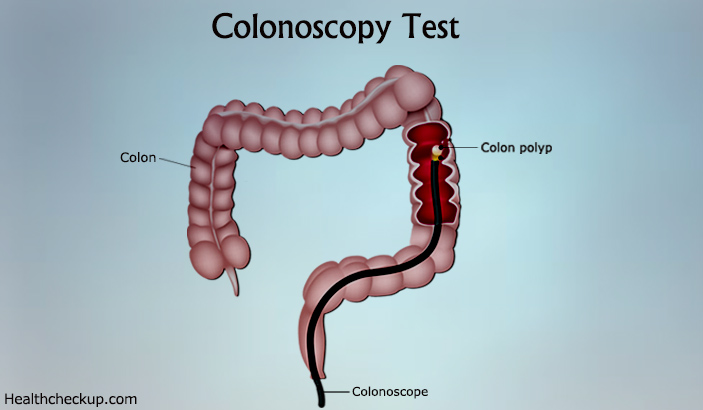A colonoscopy test is a procedure used by doctors to have a close view of the inside of the colon. The large intestine is called the colon, and it forms the last part of the digestive system. The main functions of the colon are to dry, process, and eliminate the waste leftover after the absorption of nutrients from the food in the small intestine. The colon is usually around 3 to 5 feet long, and it starts from where the small intestine ends, i.e. at the lower right corner of the abdomen and extends up to the liver, then travelling across the body to the spleen in the upper left corner of the abdomen. From here it extends down to form the rectum and the anus.
The colonoscopy test is used by doctors to screen for any conditions affecting the colon. It is especially used to detect colorectal cancer in the early stages. The doctors also use the test to check for any bleeding, sores, and irritation of the colon and their causes or to check for the inflammation of the colon that may be caused by Crohn’s disease or ulcerative colitis. The inflammation of the colon usually occurs in young adults, and if left untreated, it may lead to severe symptoms and increase the risk of colon cancer in these patients. Symptoms such as unexplained changes in bowel movements, pain during defecation, bloody diarrhea, and sudden, unexplained weight loss prompt doctors to conduct the colonoscopy test. The test is also ordered by doctors when other investigation procedures such as manual rectal examination, the fecal occult blood test that checks for blood in stools, or the barium enema test in which an X-ray of the colon is taken using barium as a radiocontrast agent to make the colon visible, yield results that suggest that a deeper investigation is needed to make a diagnosis of the colon’s condition. More recently, a special test called the Cologuard test has been used to detect colon cancer in the early stages. It is a stool-based colorectal test that looks for the presence of red blood cells (RBCs) and DNA mutations in the stools and indicates the presence of abnormal growths in the colon that may be cancerous or the precursors to colon cancer. If the test results appear positive, the doctor is likely to perform a colonoscopy test to confirm the diagnosis of colon cancer.
Colon cancer usually develops from growths such as polyps or tumors that arise from the inside of the wall of the intestines. These growths take as long as 5 to 10 years to fully develop and may not cause any symptoms in the patients during the initial stages. However, it is essential to note that persons with a family history of colon cancer are at a greater risk of developing the disease than those with no family history of the disease. This makes it necessary for people at the risk of colon cancer to undergo a screening colonoscopy test every once in 10 years to help detect the condition in the early stages, and undergo the removal of any cancer-causing growths during the procedure.
The Colonoscopy Test Procedure
An instrument called the colonoscope is used to perform the colonoscopy test. The instrument consists of a long, flexible, thin tube measuring about 5 feet in length and about 1 inch in diameter that has a fiberoptic camera attached to one end. The colonoscope is passed through the rectum and upwards to the beginning of the colon, and allows the doctor to view and examine the interiors of the colon. Only doctors who are specialized in the study of digestive and rectal diseases and who are especially trained in endoscopy and certified to perform colonoscopy are qualified to carry out the colonoscopy test.
A colonoscopy test is mainly performed when a patient has any symptoms of digestive disease or shows signs of severe diseases affecting the colon. These symptoms and signs include:
- Bleeding in the rectum that may appear bright red, black, or very dark
- Constant pain in the lower abdomen
- Unexplained, non-dietary weight loss
- Changes in bowel habits
How do I Prepare for a Colonoscopy Test? Is there a Special Diet I need to Follow?
The colonoscopy test is usually performed in a hospital lab, a clinic, or a doctor’s office depending on the facilities available. The patient is given an appointment along with certain medications and the instructions on how to use them in addition to advices relating to food intake before the procedure.
The advice given to patients undergoing the colonoscopy procedure may vary from one doctor to another, but the objective remains the same, i.e. to keep the bowel empty of any contents before the test in order to allow the doctor a clear view of the bowel wall during the test.
The patient is given a liquid diet along with laxatives or enemas for approximately 2 days prior to the test. These medications allow bowel cleansing which is often referred to as bowel preparation before the test. The laxatives and enemas may cause diarrhea that may produce a little discomfort in the patients, but they are necessary to clear the bowel of stools to allow the colonoscopy test to be successful. If the test is not successful, it will have to be repeated on a later date.
Also, in order to prepare for the test, the patient will be asked to avoid any oral intake of food or liquid from the night before the test until the colonoscopy test is completed.
What do I do after my Colonoscopy Test?
The colonoscopy test is usually performed on an outpatient basis, and you will be able to return home on the same day after the test. However, the doctor will keep you under observation for few hours after the test to allow any side-effects of the medication given during the test to wear off and make sure you don’t experience any side-effects of the medication. Some common side-effects of the medications include drowsiness, nausea, and a feeling of bloating that may last for a few hours after the test. The recovery period after the test varies from one patient to another, and it can range from a few hours to a few days. It is best to have someone drive you back home after the procedure to ensure that the side-effects of the medications do not keep you from returning home.
The results of the procedure are usually available to the patient on the same day, but if a biopsy is ordered, the results may take a few days. The doctor will give you a follow-up appointment before you leave and advice you on what symptoms you need to monitor following the procedure. He will give you information on which symptoms are normal and which symptoms should be reported to him immediately. Further, you may be asked to follow a specific diet for a few days following the procedure.
Are there any Alternatives to the Colonoscopy Test?
There are various tests that can be used to detect the diseases of the colon, and each test reveals different types of information regarding the health of the colon. Sometimes, just one investigatory procedure is enough to diagnose a colon disease, but sometimes a combination of a single procedure along with a colonoscopy may be necessary to diagnose a colon disease.
The barium enema test is a special X-ray examination of the entire colon, which requires the same preparation as the colonoscopy procedure. During this test, a liquid called barium is inserted into the colon using a small tube that is passed through the anus, and X-rays of the abdomen are taken. The liquid barium shows up on the X-rays and outlines the bowel walls, and helps detect any abnormalities or irregularities in the bowel wall.
Another test called sigmoidoscopy is performed to assess the end of the colon closest to the rectum, which is known as the sigmoid colon. Sigmoidoscopy is very similar to colonoscopy, but it requires very less preparation on the part of the patient. The test uses an instrument called the sigmoidscope which is a 2-foot long tube that allows the doctor to view the anal canal, rectum, and the sigmoid colon. Sigmoidoscopy is an important diagnostic procedure used in detection of any colon disease, but its results are limited since the sigmoidscope is much shorter than the colonoscope and does not allow the view of the entire colon.
CT scans are another type of diagnostic procedure used to investigate the health of the abdominal organs. In this test, a liquid called Gastrografin is used similar to the liquid barium used in the barium enema test. The contrast liquid is taken orally by the patient and is allowed to pass through the stomach, then the ileum or the small intestine, and finally through the colon. The scan is performed once the liquid has passed through all these parts of the digestive tract. This procedure is mainly used to diagnose any diseases affecting the abdomen and the bowel.
Balloon endoscopy, push endoscopy, and virtual colonoscopy are some of the alternative tests used instead of the colonoscopy test.
Medically Reviewed By

I am an experienced Medical/Scientific writer with a passion for helping people live a happy healthy life. My thirst for writing has followed me throughout the years – it is there when I wake up, lingering at the edges of my consciousness during the day, and teases me at night as I go to sleep.









